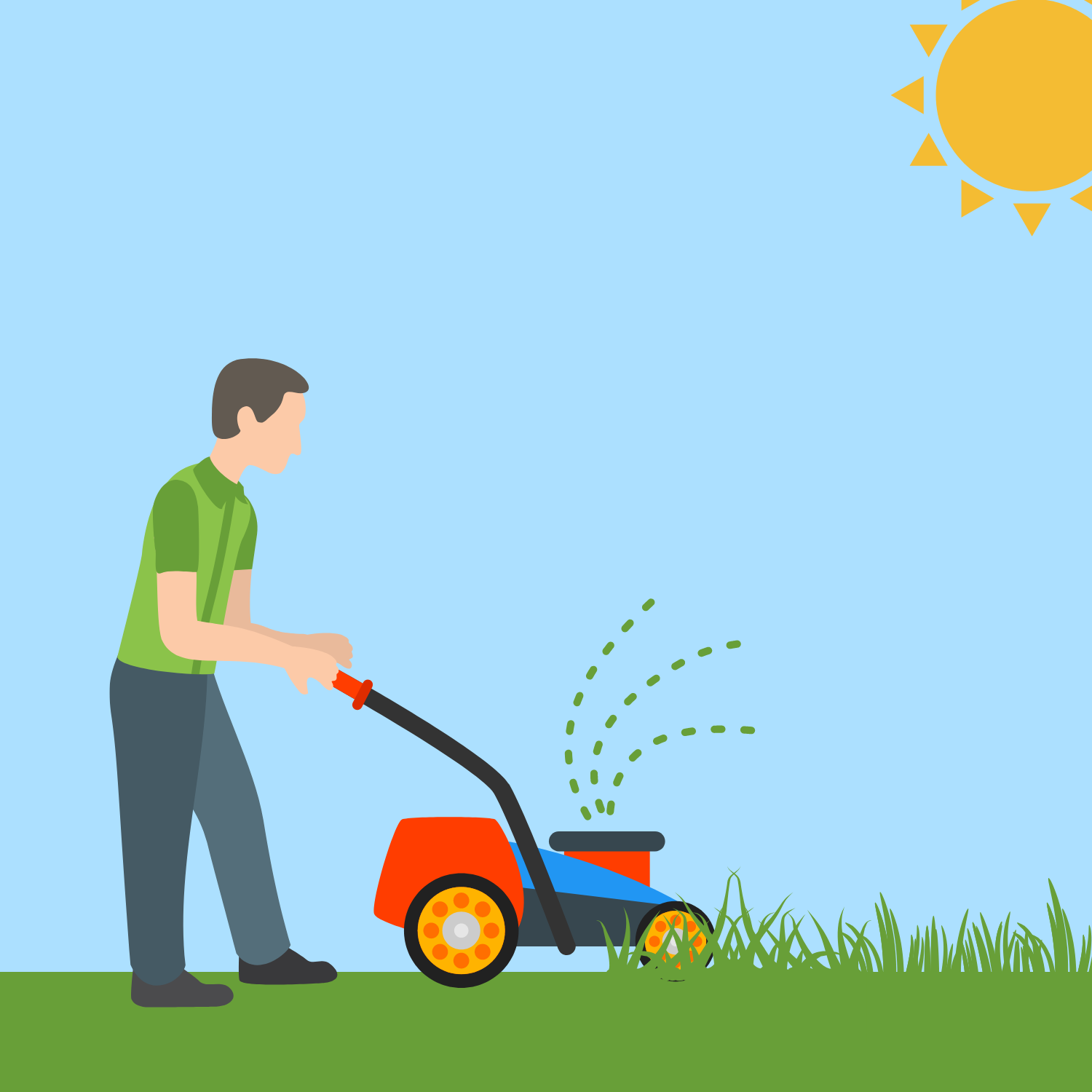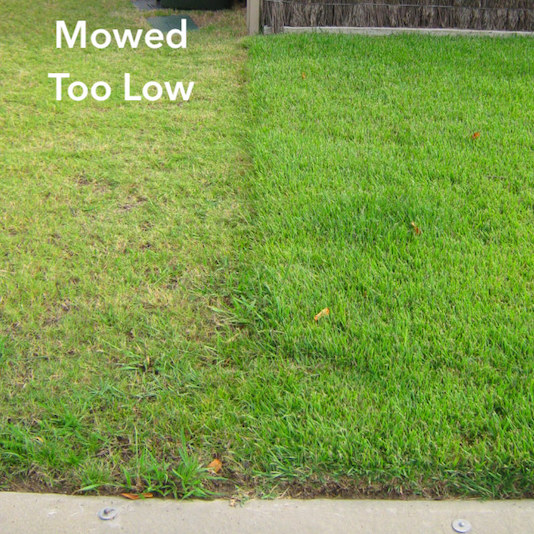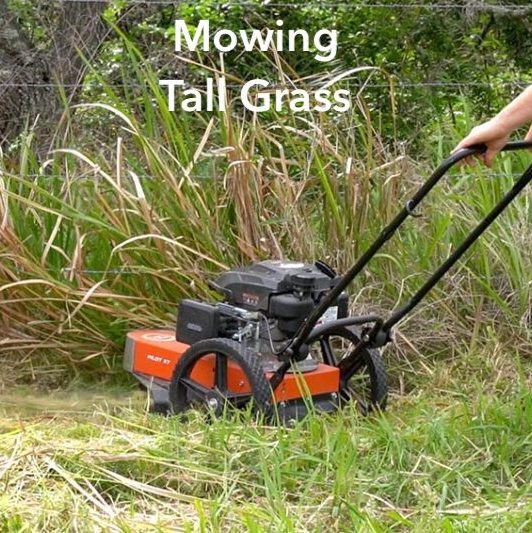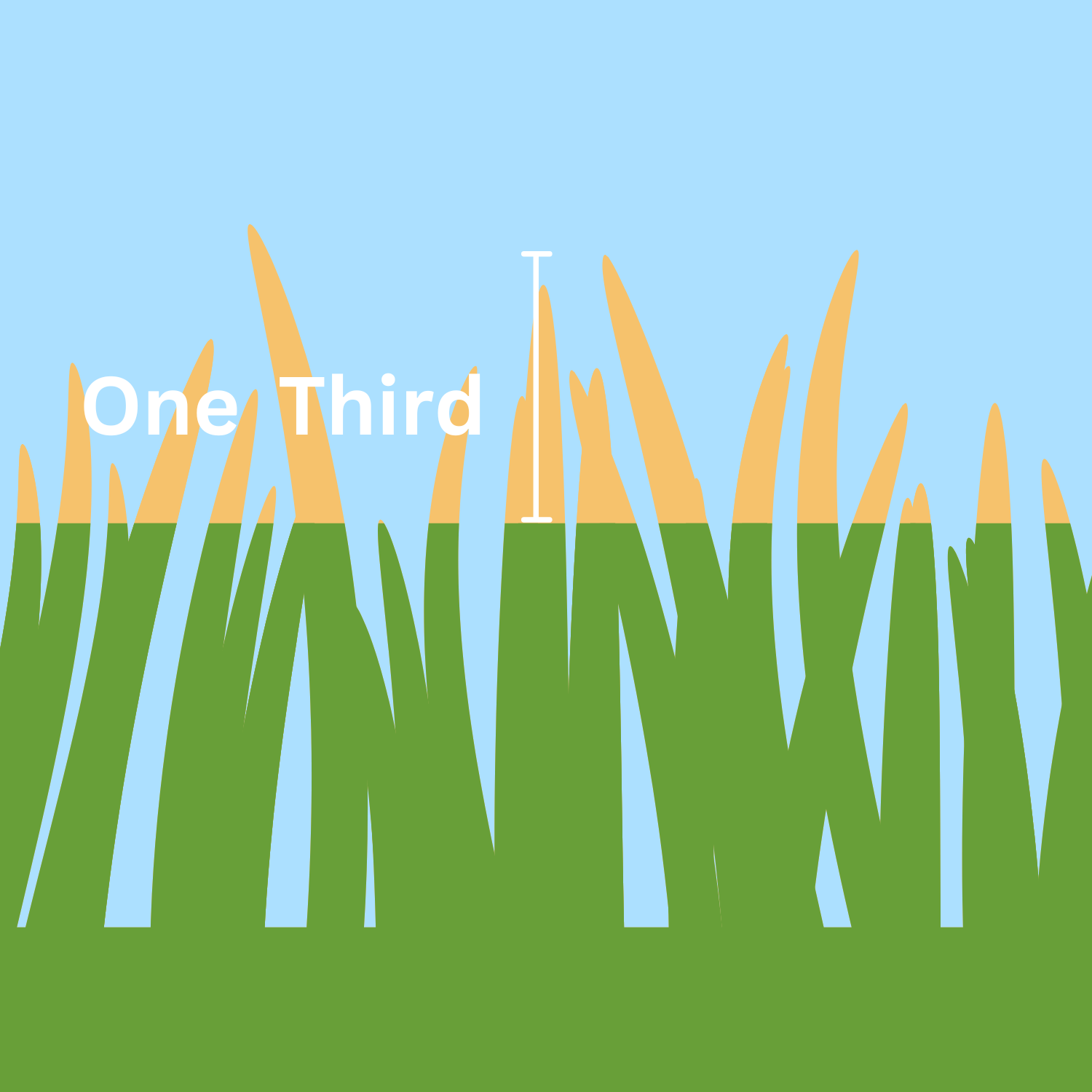
BEST PRACTICES FOR MOWING:
Mowing is the most basic and the most frequent maintenance practice for a lawn. The ability to withstand mowing is what makes grasses different from other plants, which is why mowing is an essential part of maintaining high quality and functional lawns. Not only does mowing eliminate most non-grass species, but it also increases the lawn’s tolerance for wear and tear.

Mowing Height:
Different turfgrass species have different recommended mowing heights:
Tall fescue: 5 – 7.5 cm (2 – 3 inches)
Perennial ryegrass: 1.25 – 7.5 cm (½ – 3 inches)
Kentucky bluegrass: 2 – 7.5 cm (¾ to 3 inches)
Chewings fescue: .5 – 7.5 cm (¼ to 3 inches)
Creeping red, blue or sheep fescue: 5 – 7.5 cm (2-3 inches)
Creeping bentgrass: 0.3 – 2 cm (1/8 – ¾ inch)
Colonial or dryland bentgrass: 1.25 – 2 cm (½ – ¾ inch)
Velvet bentgrass: 0.3 – 0.5 cm (1/8 – 1/4 inch)
These mowing heights are dependent on the use of the grass and the individual cultivars or varieties being used. Newer breeds may be able to withstand lower mowing heights but they may need more intense management.
Although the mowing height differences are often small, do not underestimate their importance for maintaining healthy turf.
Mowing Too Low
When turfgrasses are mowed below the recommended mowing heights the result is often a weakened turfgrass stand. When turfgrasses are mowed below their optimal range the result is a reduction in turfgrass density, reduced vegetative reproduction and a corresponding reduction in uniformity due to weed invasion, and turfgrass death. While the height of the leaf sheath of turfgrass plans is somewhat plastic (it changes with the management of the environment) there does exist a limit to this plasticity. Eventually you will mow below the collar of the plant and will be removing the entire leaf blade, drastically limiting the plants ability to photosynthesize and grow. Often this is referred to as scalping and this can occur when mowing too low for the turfgrass cultivar but also occurs when not mowing frequently enough. Often when turfgrass is scalped the individuals recover from the crowns. In some cases of severe scalping the crown itself can be damaged resulting in a loss of the turfgrass plant and the need for re-establishment of the turfgrass. In a nutshell mowing too low reduces carbohydrates, weakens turf and allows turf to be prone to weeds, diseases, insects, and environmental stresses. Maintaining proper mowing frequency can minimize scalping.


Mowing Too High
When turfgrass is maintained at a height above its optimal range there is a reduction in turfgrass density and reduced vegetative reproduction. As the height of the turfgrass increases the turfgrass begins to experience shade and responds by increasing upward growth to attain more sunlight. This results in less tillering and a decrease in turfgrass density. In addition mowing at too high of a height can result in poor mowing as the turfgrass plants begin to lay down as opposed to standing upright. In the case of sports turf this often results in a lack of playability. Very often when turfgrass is allowed to grow too tall it is then cut back to a height within the optimal range and scalping can occur. Due to the thinning of tillers in response to the self-shading this can result in increased weed invasion and reduced wear tolerance. Many of these symptoms can also be seen in turfgrass that is being grown in shaded areas.
How Often Should It Be Mowed?
Mowing must be performed at regular intervals to prevent stress. If the turf is allowed to grow too tall between mowing events, the plants are at risk of scalping.
Scalping: cutting the grass too low so that stems are exposed. This leads to browned and stressed turf.
The youngest leaf of grasses emerges from the top of the leaf sheath, so allowing excessive growth between mowing events means that the youngest fully expanded leaves will be completely removed in the mowing. This leaves behind only older leaves (which may be brown) and immature leaves. Eliminating the youngest leaves is detrimental to plant health because they are the main site of photosynthesis which is key to growth and recovery of the turfgrass plants.

The One-Third Rule
The one-third rule: never remove more than 1/3 the height of the plant during any mowing event.
What does this mean?
If your mowing height is 7.5 cm (3 “) then you should mow before the turf reaches 11 cm (4.5”) tall.
To mow at a height of 5 cm (2″) the grass should be mowed before it reaches 7.5cm (3″).
As the rate of leaf elongation is relatively constant for a particular cultivar this means that as you decrease mowing heights mowing frequency must increase. One result of decreasing the height of cut is that if the turfgrass is going to be maintained with sufficient health then mowing frequency must increase.
Recovering grass that has been let to grow too tall is important. Often for some reason or another turfgrass managers find themselves in a situation where they have the need to reduce the height of grass. This may be due to an unexpected flush of grow, or due to weather restrictions or to prepare for a major tournament. One of the most crucial times when mowing height is reduced is during establishment of a low cut turfgrass area. Initially mowing is not possible due to the lack of seedling vigor in response to traffic and the fact that seedlings are not rooted well enough to withstand the mowing process. In order for the seedlings to establish they cannot be mowed immediately. In the case of low height of cut turfgrass areas typically the first mowing occurs at a height well above the desired height.
The one-third rule should be followed when mowing but the question remains how long should the turf be mowed at each height as the height of cut is reduced. It is NOT advisable to mow one third of the plant height off every 2 days until the desired height is reached, this would be the same as just scalping it down to the desired height. The turfgrass may survive but it will be severely weakened and will very likely be subject to invasion by annual bluegrass or other weeds. Contrarily it is advised that each mowing height is maintained for a time until the grass is fully recovered from the reduction in height and is growing vigorously. In some cases this may be one to two mowing events at a particular height in other cases it may be many mowing events at a particular height. Each time you lower the height of cut you are potentially removing more leaf area. The reductions of leaf area results in less photosynthesis and a resulting decrease in turfgrass growth and recovery. Reducing the height of cut will correspond to an increase in mowing frequency. Experience is one of the best teachers when learning about reducing mowing heights. Often times inexperienced turfgrass managers will reduce the height very cautiously increasing the amount of time to get to the desired playability. In other cases inexperienced turfgrass managers will reduce the height of cut much too rapidly reducing the vigor of the stand and also leading to a longer time to acceptable playability and increased weed infestation. In some cases depending on the use level and the acceptability and the ability of the grass to recover and the availability of herbicides a turfgrass manager will reduce the height of cut rapidly to the desired height with the idea that the reduction in turfgrass quality will be acceptable for the period of time in question and the need to reduce the height of cut is more important.
Besides knowing how often to mow, it is also important to be sure to mow in multiple directions. Besides creating attractive line patterns, it makes for a smoother playing surface, and reduces wear and compaction of the field.

Clipping Removal?
A common question is should clippings be removed? Ideally, clippings should be left on the ground. However, it depends on the amount of clippings. Short clippings fall into the canopy, decompose, and add organic matter to the soil. Increased organic matter means will improve microbial activity to recycle nutrients, and enhance water retention.On the other hand, excessive clippings can cause thatch build-up, enhance disease development, or even smother the turf below.
According to this study:
- Returning grass clippings is equivalent to doubling the amount of nitrogen applied as fertilizer.
- Soil volumetric water content is 4% higher, on average, when clippings are returned.
A mulching mower is designed to chop the cut pieces multiple times to create finer clippings. This type of mower can also be used to mulch fallen leaves in autumn.
Mowing Maintenance
Maintenance to the mowers is an essential part of the mowing process. Dull mower blades lead to a reduction in the quality of cut, or smoothness. While this negatively impacts the aesthetics of the turf is also reduces turfgrass growth and recovery from mowing. Turfgrass cut with dull blades ends up frayed and leaf elongation is reduced as resources (photosynthates) allocated to defense as opposed to new growth. The rayed ends repair slower and become an ideal site for pathogens to enter the plant. Clean cutting machinery is essential for proper mowing. During times of flower production the increase in steminess leads to a lack of smoothness of cut even if the blades are kept sharp. During this time it may be necessary to sharpen the blades more often due to the increased wear on the blades. It is also important to remember that other management factors can affect blade sharpness, such as topdressing greens. Implementing light frequent topdressing programs often requires an increase in mower maintenance.
Mowing with a Dull Mower
One of the most important aspects of mowing is consistency of height. If multiple mowers are mowing one area then they must all be set to cut at the same effective height of cut. Mowers, depending on make and model and even year produced, can cut at different heights while all being set to the same height. Setting the mowers to the same effective height of cut is making sure that regardless of the setting on the mower all the mowers are cutting at the same height.
Types of Mowers
Reel mowers: are mowers that are set up so the blades spin vertically and use a scissor action to cut the blades of the turfgrass. The number of blades on a barrel varies, but typically there are between three and seven blades on a reel mower. Reel mowers are used for low cut turf and are limited to mowing turf that is lower than the diameter of the reel barrel.
Rotary mowers: are mowers that are set up so the blade spins horizontally and uses a sucking and tearing action to cut the turfgrass blades. These are all purpose mowers, and when properly set will provide uniform playing surfaces. However, when mowing turf that is above 12 cm (~ 5″) the sucking action may not be sufficient to lift up the grass blades to create a uniform playing surface.
